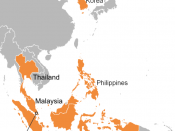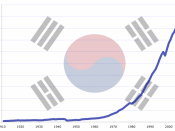A. | SOUTH KOREA'S NATIONAL INNOVATION SYSTEM (NIS) | 1 |
I. | ECONOMIC OVERVIEW | 1 |
1. | Economic development history | 1 |
2. | Major economic indicators | 2 |
II. | SOUTH KOREA'S CATCH-UP INNOVATION MODEL | 2 |
1. | Chaebol | 4 |
2. | Government | 5 |
3. | University | 7 |
III. | MAJOR WEAKNESSES OF SOUTH KOREA'S NIS | 8 |
1. | Limitation of catch-up model | 9 |
2. | Deficit technology balance of payment | 9 |
3. | Inefficient policy formulation | 10 |
4. | Chaebols' roles to be reconsidered | 10 |
5. | Heavy reliance on foreign supplies | 10 |
6. | Imbalanced concentration of R&D resources and outputs | 11 |
7. | Poor interactions among GRIs, universities and private sector | 11 |
8. | Shortage of basic research | 13 |
9. | Inadequacy and low quality of R&D manpower | 14 |
IV. | FUTURE VISION OF SOUTH KOREA'S NIS | 15 |
B. | SOUTH KOREA'S SEMICONDUCTOR INDUSTRY | 16 |
I. | OVERVIEW OF ACHIEVEMENTS IN THE SEMICONDUCTOR INDUSTRY | 16 |
II. | SOUTH KOREA'S SEMICONDUCTOR INDUSTRY IN INTERACTION WITH DRIVING FORCES | 17 |
1. | From 1965 to 1983 | 18 |
2. | From 1983 to now | 19 |
III. | CASE STUDY OF SOME SOUTH KOREA'S SEMICONDUCTOR COMPANIES | 21 |
C. | CONCLUSION | 24 |
BIBLIOGRAPHY | 25 |
�
.�
A. SOUTH KOREA'S NATIONAL INNOVATION SYSTEM
I. ECONOMIC OVERVIEW
1. Economic Development History
South Korea's innovation advancement is certainly an integral part of its history, especially the post-war time. Science and Technology policies varied in each period, being both the reason and consequence for economic performance and priorities. According to World Bank's study in 1993, Korean development history is divided into 5 main periods:
⢠War, reconstruction and land reform (1950-60)
⢠Export takeoff (1961-73)
⢠Heavy and chemical industries drive (1973-79)
⢠Functional incentives and liberalization (1980-90)
⢠Financial sector liberalization (1990-now)
Export takeoff period
The export takeoff period was characterized by the aggressive promotion of exports combined with classic import protection at home by using trade, foreign exchange and financial policies.



I think
it is pretty good
0 out of 0 people found this comment useful.